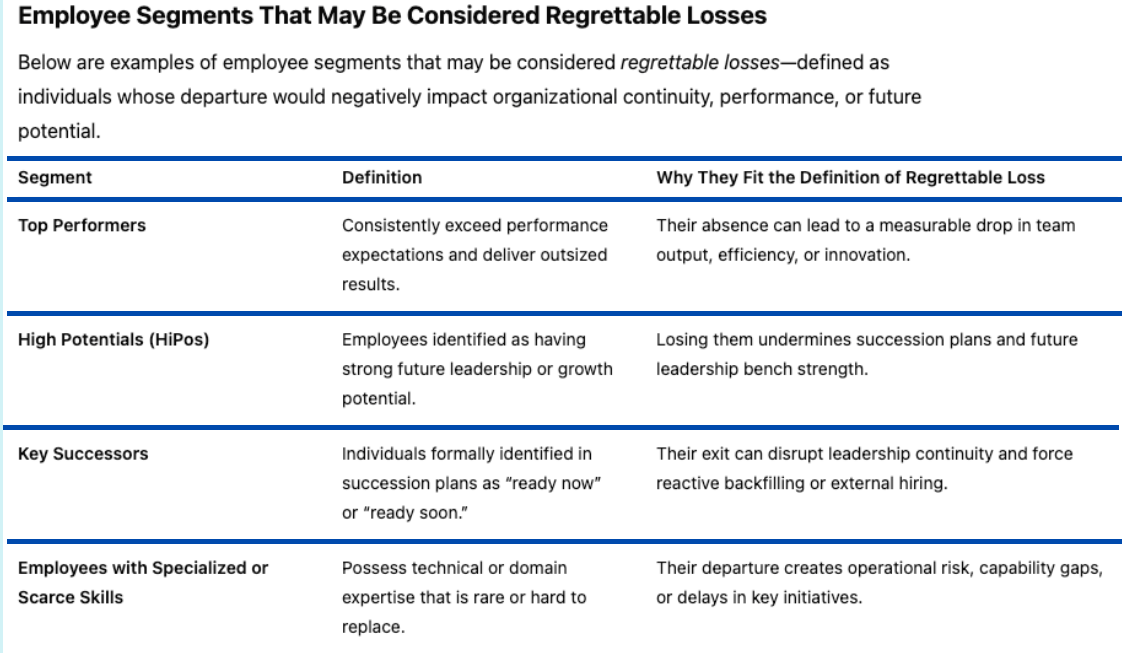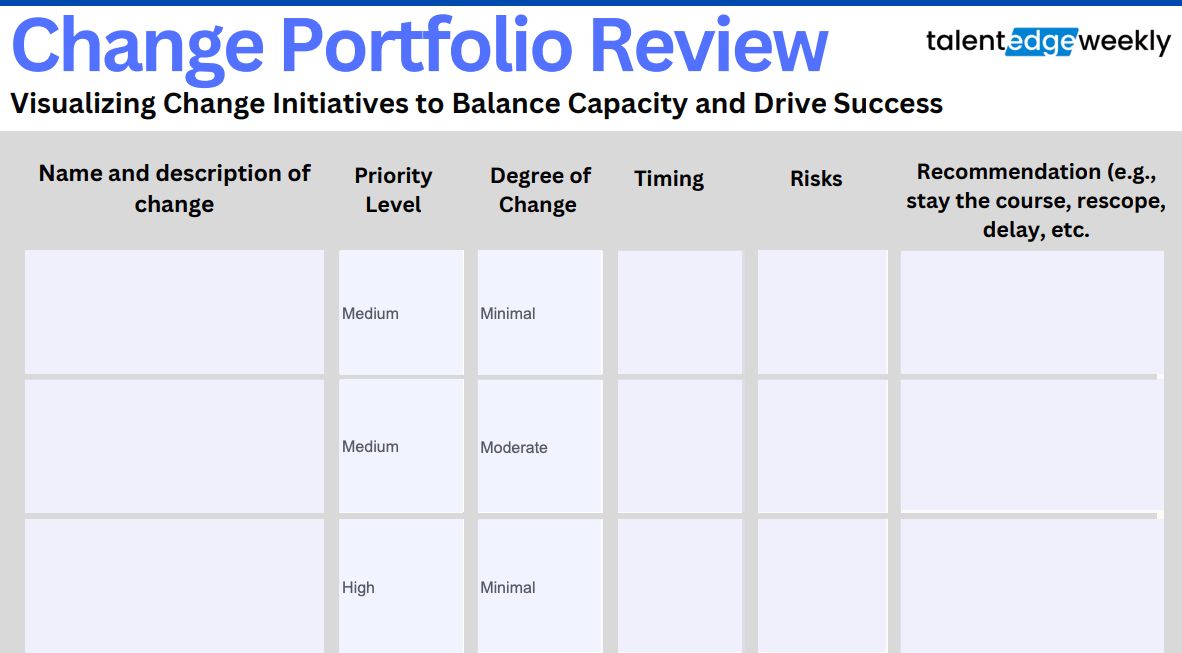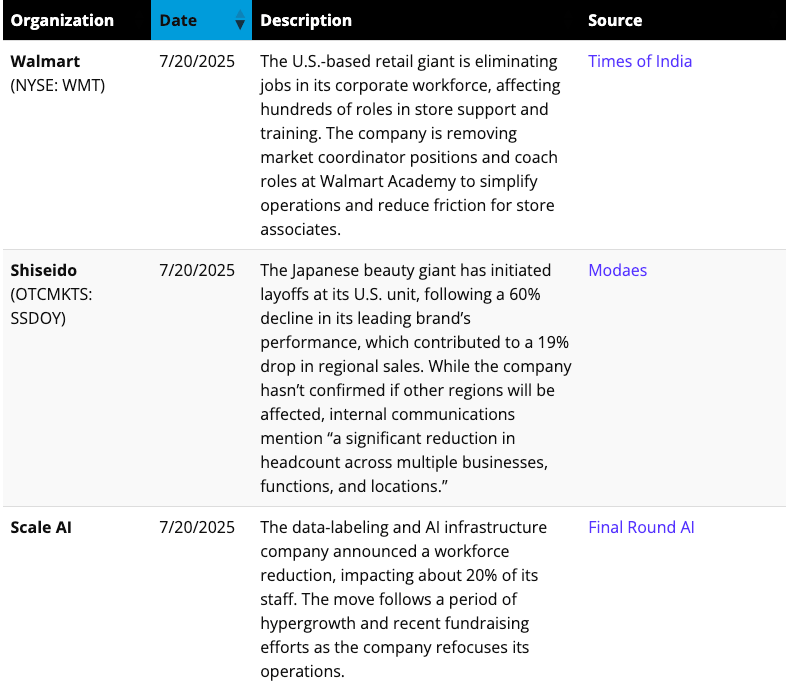- Talent Edge Weekly
- Posts
- Talent Edge Weekly - Issue #307
Talent Edge Weekly - Issue #307
Regrettable employee turnover, hiring former employees, AI in hiring and selection, AI agents curated playlist, and managing change fatigue.
Welcome to this week’s issue of Talent Edge Weekly!
A shout-out to Paul Lawrenson, VP Global Talent at Orsted, for referring new subscribers to Talent Edge Weekly. Thank you, Paul, for your support of this newsletter!
PRESENTED BY i4cp
Today’s leaders are drowning in demands—and traditional leadership models are breaking under the weight of distributed work.
i4cp’s new global study, led by renowned thought leader Rob Cross, presents a new way of thinking about leadership— and how to drastically increase productivity and performance in the age of the distributed workforce.
Key insights from the report include:
Why leadership burnout is rising—and what to do about it.
How distributed work requires a comprehensive, new approach to leadership.
Why improving the performance of lower-quartile leaders can drive a 32% productivity jump.
Download the executive brief to see the study’s four key findings—and the six capabilities that drive leadership effectiveness in distributed work.
Want to get your brand, product, or service in front of 52,000+ Talent Edge Weekly subscribers? Learn how to become a potential sponsor.
THIS WEEK'S CONTENT
Below are links and descriptions of the topics covered in this issue. If you're interested in my deep dive, you can read the full newsletter.
Employee Retention: Are You Proactively Identifying and Managing “Regrettable Losses?” | Brian Heger | My cheat sheet includes 10 examples of employee segments that may be considered regrettable losses—employees whose departure would negatively impact the organization.
Rehiring Former Employees as a Talent Strategy | Brian Heger | My cheat sheet for evaluating when rehiring a former employee might provide a talent advantage.
How AI Assessment Tools Affect Job Candidates’ Behavior | Harvard Business Review | Shares results from a study on how AI-based hiring assessments can unintentionally influence candidate behavior.
AI Agents in the Workplace: A Curated Playlist of 5 Resources | Curated by Brian Heger | Recently published resources on AI agents in the workplace—beginning with broad trends and moving into practical applications, workforce implications, and scientific research.
Understanding the Cumulative Impact of Organizational Change | Brian Heger | My one-page template to help leaders assess current and proposed organizational changes to manage change fatigue better and ensure sustainable implementation.
Also, check out my job cuts tracker & Chief HR Officer move of the week.
Let’s dive in! ⬇️
THIS WEEK'S EDGE

EMPLOYEE RETENTION
Employee Retention: Are You Proactively Identifying and Managing “Regrettable Losses?” | Brian Heger
My cheat sheet includes 10 examples of employee segments that may be considered regrettable losses—employees whose departure would negatively impact the organization.
Most would agree that managing employee retention and turnover is a critical aspect of effective talent management. While some level of turnover is both healthy and necessary, certain types of departures can have a significantly negative impact. These exits—commonly referred to as "regrettable losses"—often involve individuals whose absence disrupts key outcomes such as business performance and the achievement of organizational priorities. Although many organizations focus on retaining high-potential talent or employees who are deemed successors, regrettable turnover can also occur in less obvious segments, such as Culture Carriers (those who embody and reinforce the organization’s values and behaviors), individuals with rare cross-functional expertise, or informal team leaders. To mitigate this risk, organizations should define what constitutes a regrettable loss in their specific context and proactively identify and address retention risks across these employee segments, not just the most obvious ones. To support this effort, my cheat sheet highlights 10 examples of employee segments that may be considered regrettable losses. Building awareness of these segments is a critical first step toward mitigating undesirable retention risks.

TALENT ACQUISITION
My cheat sheet for evaluating when rehiring a former employee might provide a talent advantage.
Rehiring former employees can be a powerful talent strategy that gives organizations a distinct advantage. A study in the Academy of Management Journal found that rehires often outperform new hires in roles requiring collaboration and strong internal networks, as their organizational knowledge enables them to ramp up quickly and bridge communication gaps. Similarly, research in Organization Science highlights that returning employees tend to help both new and existing colleagues more than external hires. Still, not every rehire is the right move. Hiring managers should take a thoughtful, strategic approach—considering both (1) the organization’s current needs and (2) the former employee’s fit with today’s context, culture, and priorities. When these factors align, rehiring can offer more than just a faster ramp-up—it can accelerate performance and unlock meaningful value. To support these decisions, my quick cheat sheet helps leaders assess key considerations across both categories. As a bonus insight, an analysis by Visier found that the average time away for returning employees is 13 months (but can be up to 36 months)—and the chances of return drop sharply after 16 months, making that window a critical period for rehiring.

AI AND SELECTION
Shares results from a study on how AI-based hiring assessments can unintentionally influence candidate behavior.
The use of AI across various talent practices continues to present powerful opportunities. I recently shared my infographic featuring 12 AI-in-HR use cases, each paired with a benefit, potential risk, and mitigation tactic. The goal: help HR teams explore how AI can solve business problems while managing unintended consequences. A new HBR article reinforces this need for thoughtful use. In a study of over 13,000 participants across 12 lab and field studies, researchers found that when candidates knew they were being assessed by AI during the hiring process, they emphasized analytical traits and downplayed qualities such as empathy, creativity, and intuition. This behavior can lead to a more uniform candidate pool and reduce assessment accuracy. To address this, the authors recommend: 1) clearly explaining what traits the AI is evaluating—including non-analytical ones like emotional intelligence and creativity, 2) regularly checking for patterns that show candidates are presenting themselves in similar ways, and 3) combining AI assessments with trained human reviewers who can recognize and counteract these effects. Aside from the HBR article, there’s also the academic paper on which the article is based. As a bonus, I’m re-sharing a 36-page paper from the Society for Industrial and Organizational Psychology (SIOP), which offers recommendations for validating and utilizing AI-based assessments in employee selection.

AI AGENTS
Recently published resources on AI agents in the workplace—beginning with broad trends and moving into practical applications, workforce implications, and scientific research.
As AI agents evolve from passive tools to active collaborators, they’re reshaping how work gets done, who does it, and how teams are structured. Here are five recently published resources on the topic. 1) AI at Work: How Human-Agent Teams Will Reshape Your Workforce. Microsoft Worklab offers a comprehensive overview of how AI agents are evolving into digital collaborators. Covers implications for workforce planning, the human-to-agent ratio, role redesign, and employee reskilling. 2) Agentic AI Is Already Changing the Workforce. A Harvard Business Review article examines how AI agents are evolving from support tools to digital teammates, outlining seven key actions for integrating them into hybrid teams. 3) Seizing the Agentic AI Advantage. McKinsey dives into how agentic AI can deliver measurable value by executing end-to-end workflows. Includes a case study of a retail bank using AI agents to cut credit memo turnaround time by 30%. 4) A Day in the Life of an AI-Enabled Workforce. Deloitte utilizes three personas (new hire, VP, and CEO) to demonstrate how AI agents can personalize onboarding, optimize leadership workflows, and support strategic decision-making. 5) Collaborating with AI Agents: Field Experiments on Teamwork, Productivity, and Performance. Massachusetts Institute of Technology (MIT) presents research demonstrating how human-AI teams outperform human-only teams in terms of productivity and quality. Highlights how personality traits influence the outcomes of collaboration.

CHANGE MANAGEMENT
My one-page template to help leaders assess current and proposed organizational changes to manage change fatigue better and ensure sustainable implementation.
As many organizations implement workplace changes, such as new technologies, AI, team restructuring, return-to-office policies, or updated processes, I’ve received multiple requests for change management resources. Behind these requests is a growing concern about change fatigue: a state of physical and mental exhaustion caused by the constant need to adapt to new initiatives. According to Prosci’s Best Practices in Change Management report (May 2023), the average organization manages five major change initiatives at any given time, with many overseeing 10 or more when including smaller projects and process changes. That number is likely even higher today. Leaders who focus solely on the business case for individual change initiatives often lack visibility into the overall volume of change occurring across the organization. This can lead to a cumulative toll on teams—driving disengagement, resistance, and burnout. To help leaders gain a clearer view and manage change in a more sustainable manner, my one-page template helps initiate a holistic review of all current and proposed changes, their timing, and their impact across various groups. This editable one-pager helps organizations better align the pace of change with employees’ capacity to adapt, serving as a starting point for developing more detailed change management plans.
MOST POPULAR FROM LAST WEEK
PERFORMANCE MANAGEMENT
My one-page cheat sheet to unlock opportunities for getting more value from 1:1 performance check-in discussions.
JOB CUTS AND LAYOFF TRACKER
Check out my tracker of announcements from a segment of organizations that have conducted job cuts and layoffs since the start of 2023.
A few job cuts announced this past week:
Intel (NASDAQ: INTC). The semiconductor giant plans to cut over 5,500 jobs globally in its latest round of layoffs. The cuts will impact engineers, senior staff, and back-office staff. The latest job cuts follow Intel's earlier layoff of 15,000 workers this year.
Shiseido (OTCMKTS: SSDOY). The Japanese beauty giant has initiated layoffs at its U.S. unit. While the company hasn’t confirmed if other regions will be affected, internal communications mention “a significant reduction in headcount across multiple businesses, functions, and locations.”
Walmart (NYSE: WMT). The U.S.-based retail giant is eliminating jobs in its corporate workforce, affecting hundreds of roles in store support and training. The company is eliminating market coordinator positions and coach roles at Walmart Academy to streamline operations and minimize friction for store associates.
CHIEF HR OFFICER MOVE OF THE WEEK
This past week, 11 new Chief HR Officer announcements were posted on CHROs on the Go, my subscription-based platform tracking movement in and out of the CHRO role. This week’s CHRO move of the week is:
Johnson Controls (CORK, IRELAND) [NYSE: JCI]—global leader for smart, healthy and sustainable buildings—announced the appointment of Chris Scalia as EVP, Chief Human Resources Officer. Scalia will report to CEO Joakim Weidemanis and serve as a member of the company's executive committee. Scalia joins Johnson Controls after spending two decades at The Hershey Company, where he most recently served in dual roles as Chief Human Resources Officer and Chief Transformation Officer.
🔓️ Never miss another Chief HR Officer announcement!
CHROs on the Go has over 4,000 archived announcements in its online platform, with new announcements added daily!
If you are already a subscriber to CHROs on the Go, log in here.
FROM ME ON LINKEDIN
Catch up on what you may have missed from me on LinkedIn:
‘Read Online’ if email cuts off
THE BEST OF JUNE 2025
Did you miss the “Best of June ” issue of Talent Edge Weekly? If so, check out issue #304, which includes 18 of the most popular resources from the month.
Thank you to our sponsor, TechWolf, who sponsored the Best of June.
Listen to this podcast to see how TechWolf is helping organizations to build a skills-based talent foundation powered by AI.
Want to get your brand, product, or service in front of our active 52,000+ Talent Edge Weekly subscribers? Learn how to become a potential sponsor.
If you are not already signed up to receive Talent Edge Weekly, subscribe here to receive future issues. It’s FREE!
Talent Edge Weekly is written by Brian Heger, a human resources practitioner. You can connect with Brian on Linkedin and brianheger.com










